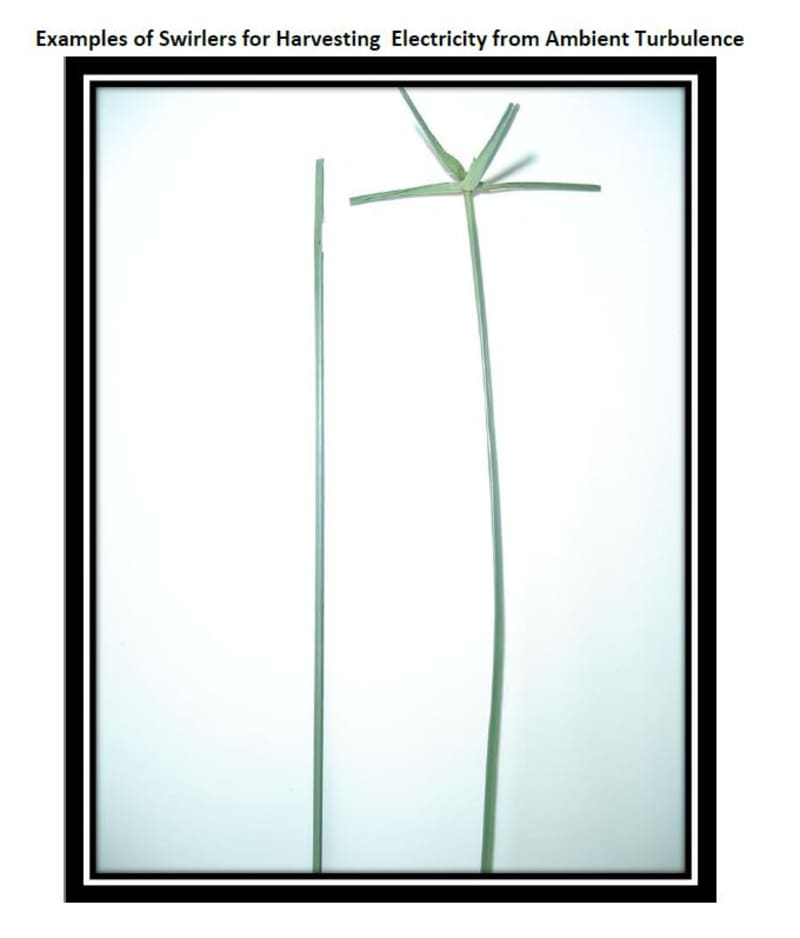As anyone knows who has changed a tire along a busy roadway, an incredible amount of turbulence is created by external airflow over and around passing vehicles. This turbulent air is an untapped, kinetic-energy resource; though, it is difficult to harness due to the chaotic intensity and irregular vectors of the energy. A system—HEAT—is proposed to convert vehicular turbulence into useful electric current. This “free” electricity can offset costs of electrical needs such as lighting of roadway features, facilities, or operating systems. Public benefits will accrue from reduced operating expenses for transportation systems as well as improved safety from expanded lighting along roadways.
The HEAT system consists of multitudes of “swirlers” which will flex, bend, and sway, as they are affected by the turbulence from passing vehicles. Electric current is generated as the swirlers move in response to the turbulence. An individual swirler generates current from the pressure changes along a piezoelectric substrate. Different swirler designs may be necessary depending on the intensity of the turbulence flow (see Figure). The “stem” of the swirler is anchored in the piezoelectric substrate and produces current as it moves. Each swirler is connected to a common circuit, where the current is used and/or accumulated with current from other swirlers.
The HEAT system is similar to the “windstalk” concept devised for the model, carbon neutral city, Masdar, Abu Dhabi (UAE). However, the swirlers are small: approximately 50 cm long and 5 mm in diameter to provide for maximum flexibility and application. Since the HEAT system is located near highly traveled roadways, there will be a fairly constant supply of turbulent energy. If the turbulence comes from a roadway, the swirlers would be situated on guardrails, “Jersey” barriers, sound attenuation walls, or tunnels. In tunnels, for example, the HEAT system might be applied in multiple strips on the walls and ceiling to maximize turbulence-scavenging capability. The generated current is collected along each strip and combined, stepped-up, transformed, and distributed to operate lighting, ventilation fans, etc. If not completely used, the excess electrical current could be returned to the electrical grid to reduce operating costs. It is expected that the capital investment in a HEAT system would pay back within three years.
The HEAT system combines reliable, available components with modular design to reduce production and life-cycle costs. Swirlers are fabricated with proven (e.g., piezoelectric) and inexpensive materials (e.g., carbon fiber); however, the HEAT system efficiency may be improved with the use of advanced materials and technologies when they become affordable. Importantly, individual swirlers must have physical attributes that allow stiffness, flexibility and mass to generate sufficient current in the piezoelectric substrate as the swirlers respond to turbulence.
Different HEAT system designs may be required depending on site-specific environmental, weather conditions (e.g, icing), or other requirements. Testing and development may be necessary to “optimize” design and performance of the HEAT system to maximize energy production at each site.
Like this entry?
-
About the Entrant
- Name:Jeffrey Short
- Type of entry:individual
- Patent status:none

